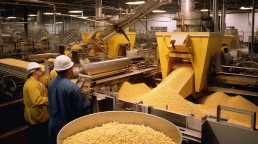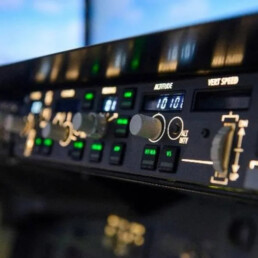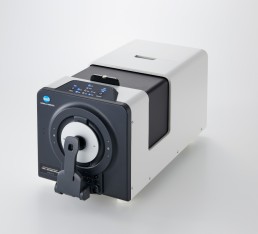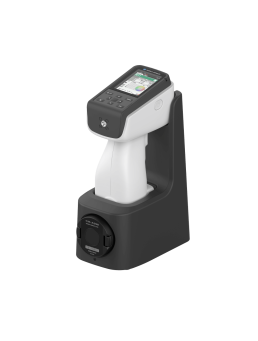Harnessing the Power of Hyperspectral Imaging: Revolutionizing the Use of Food Byproducts in the Food Industry
Understanding Hyperspectral Imaging
Hyperspectral imaging involves capturing and processing information from across the electromagnetic spectrum. Unlike conventional imaging, which captures images in three bands (red, green, and blue), hyperspectral imaging collects data from hundreds of narrow spectral bands. This detailed spectral data allows for a comprehensive analysis of materials’ chemical and physical properties.
Hyperspectral imaging can reveal a substance’s composition, structure, and quality by examining how different light wavelengths interact. This capability is advantageous in the food industry, where it can be applied to identify and evaluate food byproducts with high precision.
The Value of Food Byproducts
Food byproducts are the leftover materials after the primary processing of food items. These can include peels, seeds, cores, stems, and pulp. Traditionally, food byproducts have been considered waste and disposed of, often at a significant cost. However, many of these byproducts, especially in pineapples and papaya, are rich in nutrients, bioactive compounds, and fibers, which can be repurposed for various uses, including:
- Vitamins, Minerals, and Antioxidants
-
- Pineapple peels are rich in Vitamins A and C, calcium, and magnesium. Each can be repurposed into extracts or powders.
-
- Papaya peels and seeds are rich in Vitamins A, C, and E and multiple B vitamins. They also contain antioxidants such as carotenoids and polyphenols.
- Health Benefits
-
- Pineapple peels and cores contain antioxidants such as flavonoids and phenolic compounds, which can help reduce inflammation and oxidative stress.
-
- Papaya seeds have antimicrobial properties, making them useful in fighting bacterial and parasitic infections.
-
- Both pineapple and papaya peels and other byproducts are high in fiber, which aids in digestion and improves overall gut health.
- Industrial Applications
-
- Pineapple byproducts are an essential, nutritional, and cost-effective ingredient in animal feed.
-
- Papaya extracts can be used in cosmetics for exfoliating, skin lightening, and anti-aging properties.
-
- Pineapple extracts are utilized as natural colorants and flavor additives in food production.
By effectively utilizing food byproducts, the food industry can reduce waste and associated disposal costs, create new revenue streams, and contribute to environmental sustainability.
How Hyperspectral Imaging Enhances Byproduct Utilization
- Precise Detection and Separation
One of the primary challenges in utilizing food byproducts is the effective detection and separation of valuable components from waste. Hyperspectral imaging excels in this area by providing a high-resolution analysis of materials. It can differentiate between various types of byproducts based on their spectral signatures, enabling precise sorting and collection.
For example, hyperspectral imaging can distinguish between peels, cores, and seeds in processing pineapples and papayas. This precision ensures that valuable byproducts are not discarded and can be effectively repurposed.
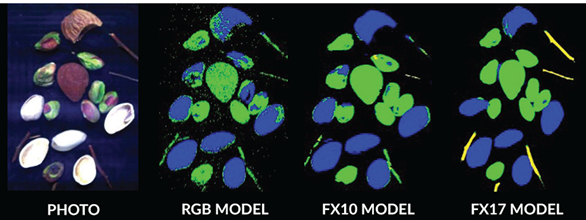
Above, an example of how the FX-10 and FX-17 Hyperspectral Cameras can classify and distinguish shells and casings, from seeds and nuts.
- Nutritional and Quality Analysis
Hyperspectral imaging goes beyond mere detection by enabling detailed analysis of food byproducts’ nutritional content and quality. By examining the spectral data, we can assess the concentration of nutrients, vitamins, and bioactive compounds in byproducts.
For instance, as mentioned earlier, pineapple and papaya peels contain high levels of antioxidants and dietary fibers. Hyperspectral imaging can quantify these components, making it easier to utilize them in the production of health supplements or functional foods.
- Enhanced Quality Control
Quality control is a critical aspect of any food processing operation. Hyperspectral imaging provides an additional layer of quality assurance by detecting contaminants, spoilage, and other quality issues in food byproducts. This ensures that only high-quality byproducts are selected for further use, enhancing the safety and efficacy of the final products.
- Cost Efficiency
Reducing waste and creating new product streams can lead to significant cost savings for the food industry. Hyperspectral imaging enables the efficient recovery of valuable byproducts, turning what was once considered waste into profitable resources. This cost efficiency can be particularly beneficial for small and medium-sized enterprises (SMEs) looking to maximize their profitability.
- Environmental Impact
The environmental benefits of utilizing food byproducts cannot be overstated. The food industry can significantly decrease its environmental footprint by reducing waste and repurposing byproducts. This aligns with global efforts to promote circular economies and reduce the strain on landfills and natural resources.
Hyperspectral imaging supports these efforts by enabling the efficient and effective use of food byproducts, contributing to a more sustainable and environmentally friendly food industry.
Applications Across Various Food Byproducts
While the focus here has been pineapple and papaya byproducts, hyperspectral imaging has broad applications across various food sources. Some notable examples include:
Citrus Fruits
Citrus fruit processing generates numerous peels rich in essential oils, flavonoids, and dietary fibers. Hyperspectral imaging can detect and quantify these components, facilitating their use in the production of natural flavorings, health supplements, and cosmetic ingredients.
Tomatoes
Tomato processing results in significant quantities of skins and seeds; these byproducts contain lycopene, a powerful antioxidant, and other valuable nutrients. Hyperspectral imaging can help efficiently extract and utilize these compounds, enhancing the value of tomato byproducts.
Grapes
Grape pomace, a byproduct of wine and juice production, is rich in polyphenols and dietary fibers. Hyperspectral imaging can analyze and separate these valuable components, which can then be used to produce nutritional supplements, animal feed, and natural colorants.
Potatoes
Potato peels and other byproducts can be a source of starch, dietary fibers, and phenolic compounds. Hyperspectral imaging enables the efficient detection and analysis of these components, supporting their use in food and non-food applications such as biodegradable packaging.
Above is an example of using Hyperspectral Imaging to create a classification chart.
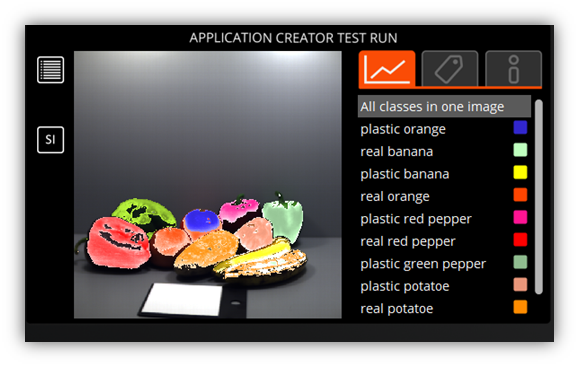
Future Prospects and Innovations
The potential of hyperspectral imaging in the food industry is vast, and ongoing research and technological advancements continue to expand its applications. Some promising future prospects include:
- Integration with Machine Learning and AI: Combining hyperspectral imaging with machine learning and artificial intelligence can enhance the accuracy and efficiency of byproduct detection and analysis. These technologies can help develop predictive models for quality control and optimize processing workflows.
- Portable Hyperspectral Devices: Advances in miniaturization and sensor technology are leading to the development of portable hyperspectral imaging devices. These devices can be used in-field or on-site, providing food processors with real-time analysis and decision-making capabilities. The Specim IQ hyperspectral camera (pictured below) already offers such capabilities.
- Automation and Robotics: Integrating hyperspectral imaging with automated sorting and processing systems can further streamline the utilization of food byproducts. Robotics can enhance the precision and speed of byproduct separation, reducing labor costs and improving efficiency.

Conclusion
Hyperspectral imaging is a transformative technology with immense promise for the food industry. It enables the precise detection, analysis, and utilization of food byproducts and offers numerous benefits, including cost savings, enhanced quality control, and significant environmental advantages. As technology continues to evolve, its applications are expected to expand, driving further innovation and sustainability in the food industry.
Embracing hyperspectral imaging can turn today’s food waste into tomorrow’s high-value products, fostering a more sustainable and profitable food processing ecosystem. The journey towards a circular economy in the food industry is underway, and hyperspectral imaging is a powerful tool to help us achieve that vision.
Products Mentioned in the Blog:
Specim IQ Hyperspectral Camera
Specim IQ drastically moves the dial on hyperspectral imaging, which previously demanded heavy instrumentation with long lag times, as it could take hours to days before the processing of results. The IQ hyperspectral imaging camera is portable, and it is an all-in-one solution that delivers imaging and results in a single device—in an instant. Weighing in at a light 1.3 kg with a generous built in 4.3″ touchscreen display, the camera contains a chargeable battery and memory card for storing captured data, putting an end to the lugging of cumbersome equipment and waiting time that once typified hyperspectral imaging.
Specim FX-10 Hyperspectral Cameras (VNIR: 400-1000 nm region)
The FX10 is an out-of-the-box hyperspectral imaging camera designed for industrial and laboratory use. Operating on visible light and near-infrared region, this lightweight hyperspectral imaging device is a heavyweight champion in its ability to detect far beyond what is possible with the human eye or an RGB camera. It is also a high-speed machine with a CMOS sensor with 512 spatial pixels and 220 spectral channels supporting 330 fps at full resolution.
Specim FX-17 Hyperspectral Camera (VNIR: 900-1700 nm region)
High sensitivity and detection accuracy beyond the capability of any other inspection method make the FX17 hyperspectral imaging camera an industry stand-out. As it operates in the near infra-red region, FX17 informs on the finest details: the percentage of moisture in a muffin, the sugar level of a potato, and even specific types of plastics being recycled. Its high image speed and resolution of 640 pixels add to its effectiveness in hyperspectral scanning for commercial use in waste sorting, recycling, threat detection, security, and food & feed inspection.
